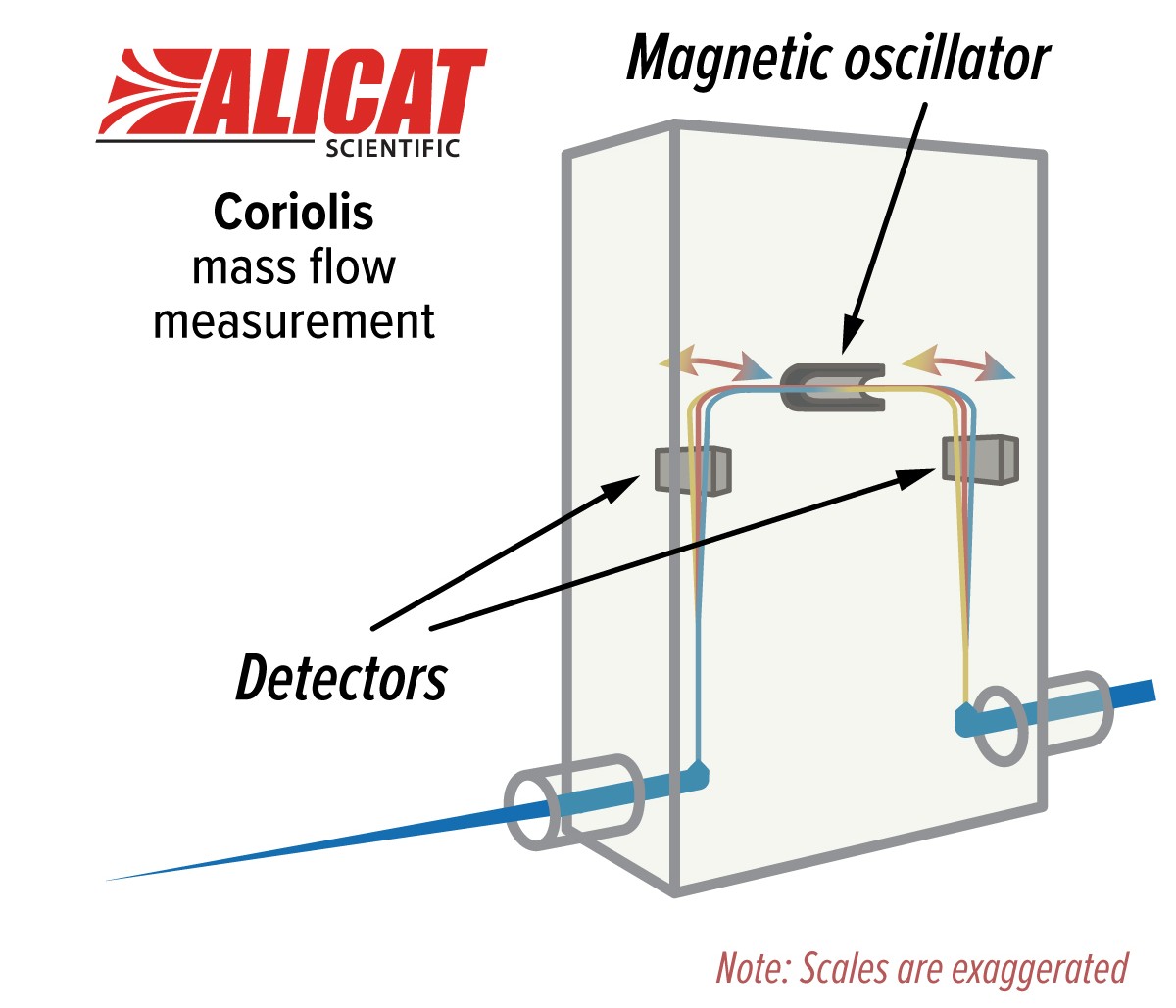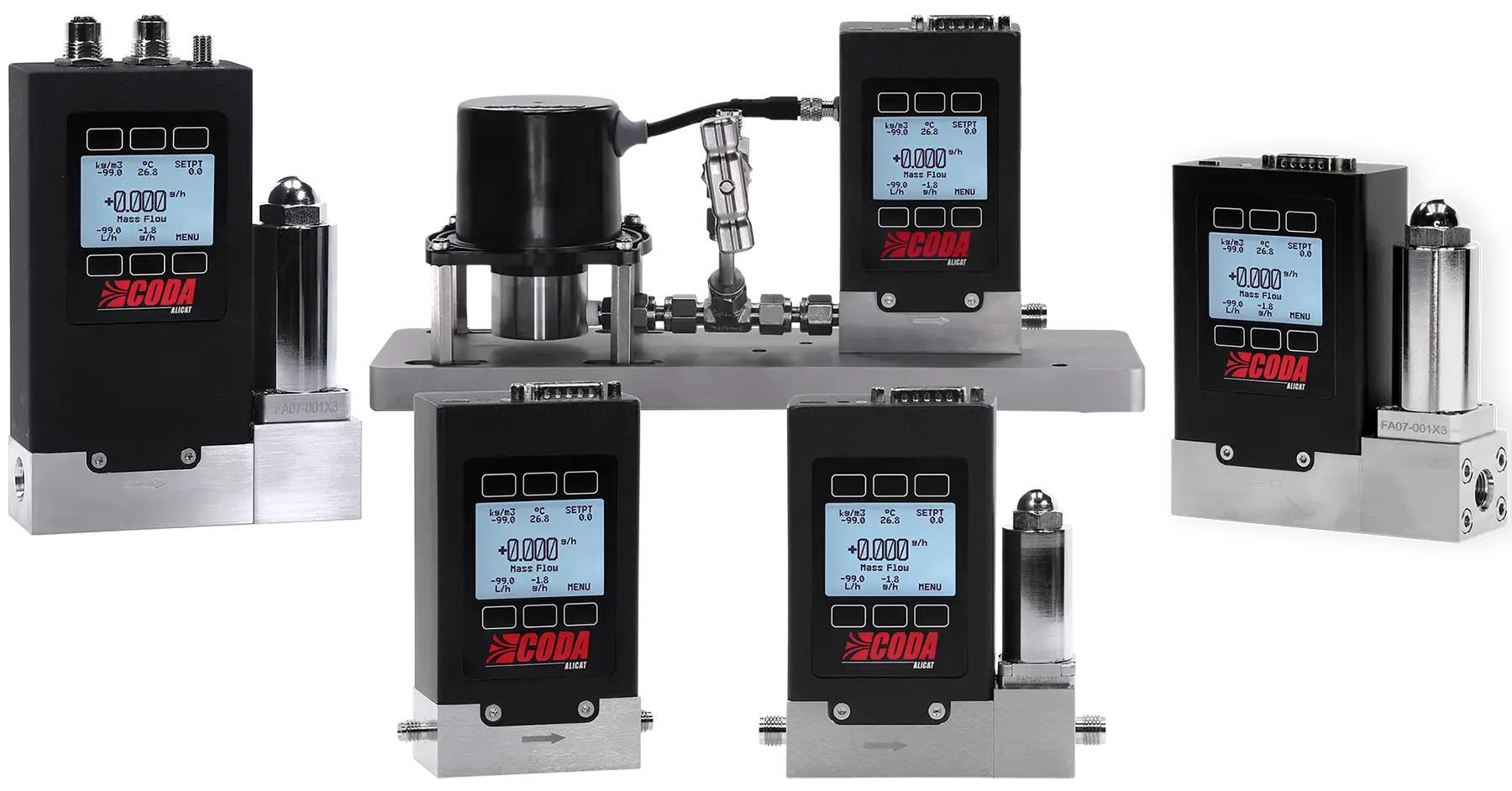Coriolis-Durchflussmesser - Funktionsprinzip
Das Prinzip des Coriolis-Durchflussmessers misst den Massendurchfluss direkt, indem es winzige Auslenkungen in einem schwingenden Rohr erfasst. Diese Seite erklärt den Coriolis-Effekt, zeigt, wie er bei der Massendurchflussmessung funktioniert, und verrät, warum sich CODA-Geräte bei Präzisionsanwendungen auszeichnen.
Die Physik hinter dem Prinzip des Coriolis-Durchflussmessers
Der Coriolis-Effekt wird häufig als Erklärung dafür herangezogen, warum sich Hurrikane, Tornados und Taifune auf der Südhalbkugel im Uhrzeigersinn und auf der Nordhalbkugel gegen den Uhrzeigersinn drehen. Dieses Phänomen wird durch die Reibungskraft der Coriolis-Kraft verursacht. Sie lenkt Objekte ab, die sich in einem rotierenden Bezugssystem bewegen. In diesem Wetterbeispiel bewegt sich die Luft durch die Atmosphäre und verschiebt sich je nach Hemisphäre nach rechts oder links. Diese Verschiebung bestimmt die Drehrichtung der Wetterkörper.
Während die Newtonschen Bewegungsgesetze beschreiben, wie sich Objekte in einem stationären System bewegen, erfordert die Bewegung in einem rotierenden System einen zusätzlichen Korrekturfaktor. Dieser Faktor, die so genannte fiktive Corioliskraft, ist für die scheinbare Ablenkung verantwortlich, die in solchen Systemen zu beobachten ist. Dies ist notwendig, weil das Objekt nicht physisch an den Bezugsrahmen oder das Koordinatensystem gebunden ist, das zur Beschreibung seiner Bewegung verwendet wird. Der rotierende Bezugsrahmen bewirkt, dass das Objekt von seiner ursprünglichen Bahn abzulenken scheint.
Der Unterschied zwischen dem beabsichtigten und dem tatsächlichen Weg ist als Ablenkung aufgrund des Coriolis-Effekts messbar. Ein Beispiel aus der Praxis, um das zu erklären: Stellen Sie sich vor, eine Person berechnet die Flugbahn eines Balls ausschließlich nach den Newtonschen Gesetzen. Die Person stellt sich dann an einen Ort in der Nähe des Nordpols und wirft den Ball direkt nach Süden auf ein Ziel am Äquator. Wäre die Erde ein vollkommen ruhiger, stationärer Bezugsrahmen, würde der Ball auf dem Ziel landen. Da sich die Erde jedoch dreht, landet der Ball tatsächlich irgendwo westlich des Ziels. Diese Ablenkung nach Westen ist umso größer, je länger der Ball in der Luft ist und je näher er am Äquator liegt.
Andere Prinzipien der Massendurchflussmessung, wie z. B. thermisch oder laminarer DP, berechnen Massendurchsätze anhand der gemessenen Temperaturänderung oder Volumendurchfluss Werte in Verbindung mit bekannten Flüssigkeitseigenschaften. Durchflussmesser und -regler, die das Coriolis-Prinzip nutzen, messen den Massendurchfluss direkt, ohne von den Eigenschaften des Fluids abhängig zu sein. Möglich wird dies durch eine geschickte Ausnutzung des Coriolis-Effekts.
Wie Coriolis-Durchflussmesser den Massendurchfluss genau messen

Ein Rohr (oder ein Satz von Rohren) wird elektromagnetisch betätigt und dient als beweglicher Bezugsrahmen. Die gesamte Flüssigkeit, die in das Gerät eintritt, durchläuft das sich bewegende Rohr und erfährt eine sehr geringe Ablenkung von ihrem vorgesehenen Weg. Sensoren messen die Größe der Ablenkung als Schwingungsphasenverschiebung zwischen verschiedenen Punkten im Rohr. Die Ablenkung hängt nur von der Masse der Flüssigkeit ab. Dadurch können Coriolis-Geräte den Massendurchfluss präzise messen, unabhängig von den Eigenschaften, der Zusammensetzung oder der Temperatur der Flüssigkeit. Ein einziger Temperatursensor misst die Temperatur des Rohrs, da sich seine physikalischen Eigenschaften je nach Temperatur leicht ändern können. Dieser Messwert stellt sicher, dass das Gerät auch unter wechselnden Bedingungen präzise Messungen durchführt.
Coriolis-Durchflussmessgeräte können sehr unterschiedlich groß sein, mit Rohrdurchmessern von wenigen Millimetern bis hin zu 30 Millimetern.
Warum CODA™ Coriolis-Durchflussmessgeräte mit niedrigem Durchfluss sich auszeichnen
Alicat® CODA Coriolis-Massendurchflussmesser und CODA Coriolis-Massendurchflussregler für Gase, sowie CODA-Zähler für Flüssigkeiten und CODA-Durchflussregler für Flüssigkeitensind miniaturisierte Coriolis-Geräte für Low-Flow-Anwendungen. Sie decken einen weiten Bereich niedriger Durchflüsse ab, von 8 g/h bis 300 kg/h. Sie arbeiten zuverlässig mit unbekannten Gasen und Flüssigkeiten.
CODA-Geräte messen Massendurchfluss, Dichte und Temperatur gleichzeitig. So können sie Änderungen dieser Bedingungen kompensieren und genau bleiben, während sie Ihnen multivariate Informationen melden. Sie sehen die Daten auf dem Programmierdisplay auf der Vorderseite, über digitale Kommunikation oder über analoge Übertragung. Die Coriolis-Geräte von Alicat haben eine robuste Vibrationstoleranz ohne übermäßiges Gewicht und können gut in lauten Umgebungen arbeiten, die andere miniaturisierte Coriolis-Geräte stören.
Dieses Video demonstriert den Messprozess und zeigt, wie das Prinzip des Coriolis-Durchflussmessers in CODA-Geräten eine unübertroffene Präzision liefert.
CODA Coriolis-Anwendungen mit geringem Durchfluss und neueste Innovationen
Prüfung von Brennstoffzellen
Wenn die Prozessbedingungen hohe Drücke und niedrige Durchflussraten beinhalten, bietet ein CODA Coriolis-Massedurchflussregler eine zuverlässige, hochpräzise Lösung.
Farbdosierung mit geringem Durchfluss
CODA Coriolis-Durchflussmesser liefern wiederholbare, präzise Massendurchflussmessungen für Flüssigkeiten und Gase mit geringem Durchfluss. Integriert in Farbdosiersysteme liefern sie Echtzeit-Rückmeldungen an die Pumpen und sorgen so für konsistente Dosierung, weniger Abfall und Prozesswiederholbarkeit.
Optimierung der Slot-Die-Beschichtung
Bei Präzisionsbeschichtungsanwendungen wie der OLED-, Batterie- oder Solarpanel-Produktion gewährleisten CODA Coriolis-Massedurchflussregler stabile, genaue Durchflussraten mit einer Messgenauigkeit von bis zu ± 0,2%, selbst bei Flüssigkeiten mit unbekannter Zusammensetzung. Dies garantiert vorhersehbare, gleichmäßige Schichtdicken.
